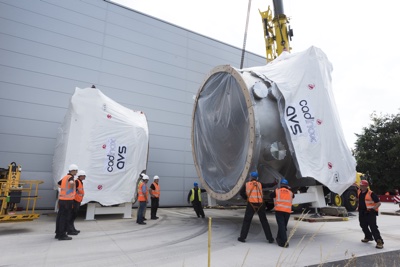STFC RAL Space has successfully installed the second 5m diameter by 6m long thermal vacuum chamber, helping to ensure the UK remains a world leader for space technology.
This is the second test chamber of its size to be installed at RAL Space in Oxfordshire. Alongside its twin space test chamber, it is the biggest in the UK and one of the largest in Europe.
The new test chamber increases RAL Space's capacity to meet growing demand from the space industry to test how instruments and small spacecraft work in space-like conditions. The new chamber will also help to ensure that the UK, through RAL Space, can meet demand from the country's space sector, which is growing from strength to strength.
This capability will enable the UK space industry, which is worth more than £13 billion, to win more national and international contracts for bigger and more technologically advanced satellites and reduce the need for UK companies to use test facilities located abroad.
Dr Chris Mutlow, Director of STFC RAL Space said “This is another exciting step for STFC RAL Space as we expand our existing world-class test facilities to meet increasing demand from the space sector. We're looking forward to getting the test chamber up and running so that our expert staff can start putting the next generation of spacecraft through their paces."
The chamber, when complete, will simulate the conditions and extreme temperatures spacecraft may have to operate in. It is capable of reaching temperatures ranging from -180 to +120 °C while maintaining the vacuum of space. The chamber is also situated within a specialised cleanroom environment, which is required for the preparation and installation of the items that will be tested within the facility.
The chamber embarked upon a seven-day and approximately 1000-mile journey from its manufacturers in northern Spain to RAL Space in Oxfordshire. It was delivered in two halves on separate lorries, each half vessel weighing roughly 24 tonnes. A team of 15 people worked over four days to unload, unwrap, clean and re-join the chamber.

It was delivered in two halves on separate lorries, each half vessel weighing roughly 24 tonnes
It was installed in its final position late in the day on Thursday (July 27) and aligned with the 300-tonne seismic block – which will prevent the chamber from being affected by external vibrations. Spacecraft do not experience vibrations in space so any movement could affect the tests.
Electronics, control box and vacuum equipment were the last to be installed before the chamber began site acceptance tests on Monday (July 31). This process will conclude in May next year, ready for the first customer; the instrument for the Earth observation satellite Sentinel 5.
Dr Brian Bowsher, Chief Executive of the Science and Technology Facilities Council, said: “This new test chamber puts the UK ahead of the game internationally when it comes to being able to test spacecraft and satellites. “We are looking forward to welcoming some of the world's most exciting space technology to our test facilities, where they will be put into the hands of our incredibly skilled staff.
The UK Government also recently invested £99million into a National Satellite Test Facility (NSTF) which will continue to expand RAL Space's capabilities. NSTF will provide a comprehensive world-class set of co-located facilities for the assembly, integration and testing of space payloads and satellites.




